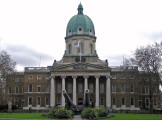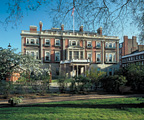When we look—what do we see? The Amazing World of M.C. Escher
Originally published in October 2017 in American in Britain Magazine, September 2015
Maurits Cornelis Escher (1898-1972) was known for creating some of the most memorable graphic images of the 20th century. Although his work is less well known today, he is best remembered for iconic record jackets and posters which hung on the walls of hippies in the 1960s. It is somewhat odd that despite his artistic reputation the only Escher print owned in Britain today is the mesmerising Day and Night, 1938, in the Hunterian collection at Glasgow University. Today we are most fortunate to be able to examine Escher’s compelling visions in a retrospective exhibition at the Dulwich Picture Gallery.
When we look—what do we see? he Amazing World of M.C. Escher
By Abby Cronin
Maurits Cornelis Escher (1898-1972) was known for creating some of the most memorable graphic images of the 20th century. Although his work is less well known today, he is best remembered for iconic record jackets and posters which hung on the walls of hippies in the 1960s. It is somewhat odd that despite his artistic reputation the only Escher print owned in Britain today is the mesmerising Day and Night, 1938, in the Hunterian collection at Glasgow University. Today we are most fortunate to be able to examine Escher’s compelling visions in a retrospective exhibition at the Dulwich Picture Gallery where the show has moved after closing at the Scottish National Gallery of Modern Art in Edinburgh. At the Dulwich you will find a showcase of nearly 100 of his greatest drawings and prints. A master of illusion and paradox, M.C. Escher’s prints evoke multiple levels of time, space and perception. He evolved a unique visual language.
Escher was born in the small provincial town Leeuwarden, Holland. He grew up with several siblings in a comfortable family environment. In his teens he developed a distinct talent for learning printing techniques and graphic skills despite some unhappy years at secondary school where his marks were poor. Although he suffered a bout of ill health in 1918 he continued to produce prints. When he enrolled in the School of Architecture and Decorative Arts in Haarlem in 1919, his tutor Samuel Mesquita immediately recognised his talent for graphic work. Working with Mesquita enabled Escher to abandon his study of architecture and concentrate on training as a graphic artist. After mastering woodcut printing skills, he went on to learn the precision techniques required to make prints of perfectly executed images in the form of engravings, lithographs, copper plates and linocuts.
Travels to Italy, Switzerland and Spain exposed Escher to the marvels of architecture and stimulated a profound appreciation for and interpretation of natural landscapes. When he visited Granada and saw the remarkable tilings in the Moorish Alhambra palace, he became fascinated with their symmetry, order and the regular division of planes. The technique of dividing planes was to feature in his designs throughout his fifty-year career. His “so-called ‘tessellations’….are arrangements of closed shapes that completely cover the plane without overlapping and without leaving gaps…[He] delighted in replacing the abstract patterns of Moorish tiles with recognizable figures…”(1) His tessellations attracted interest from mathematicians and scientists – especially the Cambridge mathematician Roland Penrose who published an article entitled “Impossible Objects: A Special Type of Visual Illusion”. (2) And the noted art historian Gombrich cited Escher’s art for its groundbreaking study of the psychology of visual perception in Art and Illusion, 1960.
A great deal of the literature about Escher’s art is organised and classified in descriptive categories. Within the categories the techniques used are discussed. An early work, his first woodcut, Eight Heads, 1922, clearly illustrates his tessellation technique. Eight Heads consists of repeating the central motif once in its entirety and several times partially. The pattern seamlessly interlocks in every direction and suggests a continuous closed loop. (3) When gazing at Eight Heads, viewers need to take time in order to appreciate the idea that eternity and infinity are revealed in a continuous integrated pattern. Day and Night, 1938, is another woodblock printed in black and white made from two blocks. Described as an iconic representation of the Dutch landscape, this exceptionally brilliant image is a complex aerial view of grey rectangular fields which develop upwards into silhouettes of white and black birds. White and black birds fly up from the flat land between two rivers. They evolve from shadows and fly towards the sunrise. The day and night landscapes are mirror images of each other.
Gazing at Escher’s extraordinary lithograph Hand with Reflecting Mirror (Self-Portrait in Spherical Mirror), 1935, reveals what has been described as an ‘Escherian double take’ — an optical illusion – a tension inherent in representing three dimensions on a two-dimensional surface. At first glance the depth and perspective in this lithograph seem to hide behind eyes staring straight at the viewer. Here, Escher is seated in his living room in Rome, where the family lived at the time. The portrait is inside a sphere, which rests on his right hand; the sphere is so close to the viewer that it may feel that the viewer is looking at his own hand. Escher wrote of this image “His head, or to be more precise the point between his eyes, comes into the absolute centre. Whichever way he turns he remains at the centre.”(4) A mirror, and everything it reflects, is the subject of this print. Here space is distorted by a convex reflective surface.
The famous lithograph Drawing Hands, 1948, is described as one of Escher’s most celebrated and economically paradoxical works. (5) Here we see the right hand sketching the cuff on a left hand while the left hand is simultaneously sketching the cuff on the right hand. The hands sit on a piece of flat sketch paper but the hands take on a three-dimensional perspective. Comments about this lithograph suggest that these ‘drawing hands’ represent a purely mental and imaginative concept because the set of hands is performing the physically impossible.
Relativity, 1953, weaves different perspectives together; it expresses confusion – even dizziness. How can we interpret this print? One viewer has read Escher’s Relativity as an image that evokes the confused and unhappy school days he spent in his adolescent years. What is inside; what is outside? By combining different vantage points in a single work, Escher captures a visual and psychological experience within spatial settings and interiors. Movement within this space is impossible; spaces continuously run into one another. In the catalogue the interpretation of this print explains that the print “seems to show a man walking up a staircase. But a closer inspection quickly leads to a dizzying sensation produced by so many different perspectives combined in one image. Each man walking up a staircase would appear to be paired with another on the underside of the staircase, in a different world. Unexpected perspectives are hidden between all the different stairways. Space and motion merge in a fluid visual symbiosis.”(6) Several prints in the exhibition draw on similar architecturally precise interiors which express levels of visual confusion. They are mesmerising.
The diversity of Escher’s subjects is intriguing. Take, for example, Bond of Union, 1956, a woodcut. Two spirals merge and portray a woman’s head on the left and a man’s on the right. Here the spirals unite both in an endless band with foreheads intertwined – a double unity. It represents double image of himself and his wife. Spheres float and magnify the space that surrounds these hollow heads. In Circle Limits III, 1959, another woodcut, we find a dense spatial circular design in which all the fish swim in one string. There are diminutive fish progressing in the opposite direction. They swim behind each other following a curving path at an equal rate within the limit of the circle. Here Escher demonstrates yet again his mastery of geometry.
Recognition of Escher’s art began to emerge the 1930s while he was living with his family in Switzerland. One of his core themes, the idea of a “metamorphosis”, is that a shape or object could be shown to turn into something completely different. This is clearly seen in his landscape prints and in many other works. However, it was not until the 1950s that his work was admired worldwide. His popularity was boosted when two articles in the American magazines Time and Life appeared. In 1954 he had his first one-man exhibition in the Whyte Gallery in Washington, D.C. However, it is worth noting that although he was a contemporary of Magritte and Dali, he kept his distance from the contemporary art world and did not regard his work as surrealist.
A close friend, J.L. Locher, described Escher’s work as one with an absurdist sense of humour. They are picture-puzzles which play games with elements and contain cherished memories. His “picture-thoughts exhibit systematic principles of construction that appear to have very little to do with aesthetic laws. (7) But they are realised with craftsman-like passion.
It is a privilege to have the opportunity to view previously unseen archive material on loan from the collection of the Gemeentemuseum Hague, The Netherlands. Escher’s work will be displayed chronologically and stretch across his fifty- year career. Be sure to catch this exceptional exhibition. The show is appropriately described as a one-man movement. So – put the dates in your diary: The Amazing World of M. C. Escher–14 October 2015 – 17 January 2016. You will not be disappointed.
___________________________________________________________________________
The Amazing World of M. C. Escher–14 October 2015 – 17 January 2016.
Dulwich Picture Gallery
Gallery Road, London SE21 7AD v
http://www.dulwichpicturegallery.org.uk/
IMAGES: Courtesy of the Dulwich Picture Gallery
All M.C. Escher works © 2015 The M.C. Escher Company-The Netherlands. All rights reserved. www.mcescher.com
________________________________________________________________________________________
Notes:
- M.C. Escher. Publisher- Taschen p.19
- Elliott, P. chapter on ‘Escher and Britain’ in Exhibition catalogue: The Amazing World of M.C.Escher. Publisher: National Gallery of Scotland in Association with the Gemeentemuseum Den Haag. The Hague. 2015
- Exhibition catalogue p 41-43
- Exhibition catalogue p. 65
- Exhibition catalogue p.104
- Exhibition catalogue p.118
- Locher, J.L. The Magic World of Escher, Thames & Hudson 2000 p 19
Get in Touch: Abby Cronin –
artsjournalist@abbycronin.co.uk
Website: www.abbycronin.co.uk




